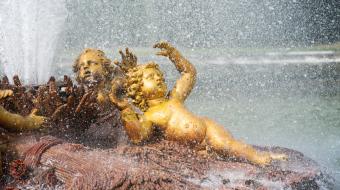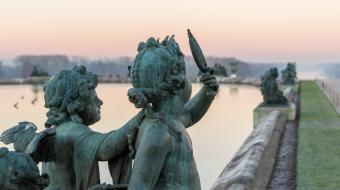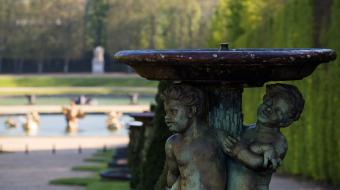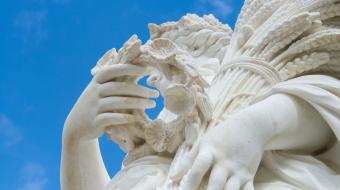Bowers of greenery in the wooded areas off the pathways, the groves form small gardens closed off by walls of greenery or trellises and reached by discreet paths up to their gates. The Marquis de Dangeau, a contemporary of Louis XIV, referred to them as "enclosed fountains". Adorned with fountains, vases and statues, they introduced an element of surprise or fantasy within the greater garden and served as veritable open-air salons.
Under the reign of Louis XIV the gardens of Versailles contained fifteen groves. Contrasting with the strict regularity of the general layout of the gardens, they had a variety of décors and shapes and never failed to surprise visitors with their diversity. André Le Nôtre created most of the groves, but some were modified by Jules Hardouin-Mansart. However, some of the groves deteriorated rapidly, as they were costly and difficult to maintain, and disappeared in the 18th century. One of the most famous, the Labyrinth, was destroyed when the gardens were replanted in 1775-1776. Others, like Apollo's Baths, were converted to the Anglo-Chinese style that was much in vogue during the reign of Louis XVI and Marie-Antoinette. In the 19th century the Royal Island was filled in and became the King's Garden, planted with rare and exotic trees.
The Southern Groves
Queen's Grove

This grove replaced the famous Labyrinth grove, installed in 1665-1666 and enhanced in 1677 with a series of thirty-nine painted lead fountains in a lifelike representation of the animals in Aesop's fables. This wonder was destroyed when the gardens were replanted in 1775-1776 and replaced by today's grove, initially called Venus's Grove and later the Queen's Grove. Simple but elegant, the new layout was designed to highlight, in its centre, a new type of tree recently introduced in France: the Virginia tulip tree. Today's sculpted décor was added at the end of the 19th century.
Restored thanks to the patronage of numerous companies, foundations and institutions, both French and foreign, as well as a hundred or so private individuals, the Queen's Grove now opens its doors during the days of the Fountain Shows and Musical Gardens.
Restoration of the Queen's Grove
Ballroom Grove

The Ballroom Grove was the last grove to be laid out in the gardens by Le Nôtre. The works began in 1680 and were completed in 1685. The Grand Dauphin, the son of Louis XIV, organised a great dinner there to celebrate its inauguration. The grove was designed as an amphitheatre of greenery. The central arena had a small island surrounded by a canal on two levels and reached by four small bridges. Intended for dancing, the island was eliminated by Jules Hardouin-Mansart in 1707. Le Nôtre put the considerable incline created by the ramps to Latona's Parterre to skilful use by designing a great cascade – the only one in Versailles – taking up the whole eastern end of the amphitheatre. The cascade has eight levels, is punctuated by marble ramps, and was decorated with millstones and shells, along with tall pedestals and gilt lead vases. The tiers intended for spectators were highlighted by boxwood hedges.
Girandole Grove

Along with the Dauphin's Grove, its corresponding grove to the north, the Girandole Grove was one of the first groves to be laid out by Le Nôtre in 1663. Designed as green bowers, each has a central chamber adorned with a fountain installed in 1669. To the south, the border of the pool was decorated in 1682 with a reed motif: water jets converged toward the centre of the pool, where a water spout sprang from a metal basket of flowers painted in a lifelike manner. The shape of the spout, which resembles that of a girandole, gave its name to both the pool and the grove. The pool disappeared in about 1760. The grove itself, like the Dauphin's Grove, was eliminated when the garden was replanted in 1775-1776 and replaced with a vast space planted with linden trees arranged in staggered rows. In 2000 the two groves and their fountains were restored to their original state.
Colonnade Grove

Closure
The Colonnade Grove is exceptionally closed until June 6th included.
Commenced in 1685 by Jules Hardouin-Mansart, the Colonnade replaced the Spring Grove created by Le Nôtre in 1679. A circular peristyle with a diameter of forty metres is supported by thirty-two pilasters that act as buttresses for the arcades supporting thirty-two Ionic columns. The pilasters are all made of Languedoc marble, while the columns alternate between deep blue marble, purple breche marble and Languedoc marble. This discreet colour scheme helps to offset the whiteness of the Carrara marble in the arcades and the vases on the cornice. The sculpted décor of the spandrels was executed in 1682 and 1687 by the sculptors Coysevox, Le Hongre, Tuby, Mazière, Leconte, Granier and Vigier, and represents cherubs playing music or engaged in rustic games. Under twenty-eight of the thirty-two arcades, whose keystones are adorned with masks of marine or rustic divinities, leaping fountains tumbled into a channel surrounding the peristyle. In the centre, the original pool was replaced in 1696 by the group sculpture by Girardon: The Abduction of Proserpine by Pluto.
Chestnut Grove

The layout of the Chestnut Grove resembles a verdant gallery adorned with a fountain at each end. It replaced a grove designed by Le Nôtre in 1678: the Ancient gallery, where in 1680 Louis XIV ordered a remarkable collection of ancient sculptures or sculptures modelled on ancient sculptures to be positioned on pedestals rising out of the canal surrounding a central section with polychrome tiling. The extremities of this veritable open-air museum were enhanced with fountains. In 1704 Jules Hardouin-Mansart eliminated the fountains and the central island, replacing them with two rows of chestnut trees.
The Northern Groves
Grove of the Domes

This grove was frequently refashioned and its name changed as the decor was modified. Created by Le Nôtre in 1675, it has an amphitheatre design with the central arena occupied by a hexagonal pool surrounded by a golden metal balustrade adorned with eighteen pillars, each projecting water that gushes into the pool. Higher up, the amphitheatre is circled by another balustrade of white marble with red marble pilasters adorned with bas-reliefs. In the centre of the pool, a statue of Fame gave its name to the grove. With his first intervention in the gardens, between 1677 and 1681, Jules Hardouin-Mansart built two richly adorned pavilions crowned with domes, one on each side of the amphitheatre. They were demolished in 1820. Between 1684 and 1705, the grove was home to the three sculpted groups from the Grotto of Thetis, which had just been demolished (Apollo Served by Nymphs and the two Horses of the Sun groups) and came to be known as Apollo's Baths Grove. It then acquired its definitive name as the Grove of the Domes. In 1705, the balustrade at the pool was replaced by a new balustrade consisting of white marble balusters, with the ramps and pillars carved from red marble, making it a kind of negative of the upper ramp. Finally, in 1708, the central fountain was replaced by a white marble bowl propped up by dolphins.
Enceladus Grove

The Enceladus Fountain was made of lead by Gaspard Marsy between 1675 and 1677. The subject is borrowed from the fall of the Titans, buried under the rocks of Olympus by the gods they had wished to dethrone. The sculptor portrayed the giant Enceladus half-buried under a pile of rocks, struggling to survive, and captured his suffering by having a powerful water jet spring from his mouth like a cry. The design of the grove, its surroundings punctuated with trellis pavilions linked by bowers, was entirely modified in 1706 by Jules Hardouin-Mansart, who transformed this enclosed space into an open crossroads by removing the trellises, the small pools and the original differences in level. A restoration programme conducted between 1992 and 1998 restored the original appearance of the grove.
Obelisk Grove

The general outline is all that remains of the Feasting Chamber Grove laid out by Le Nôtre between 1671 and 1674 and completely redesigned by Jules Hardouin-Mansart in 1705-1706. The architect installed a vast rectangular pool on two levels with a multitude of jets forming a liquid obelisk. The upper pool tumbled through four cascading stairways into the lower one.
Apollo's Baths Grove
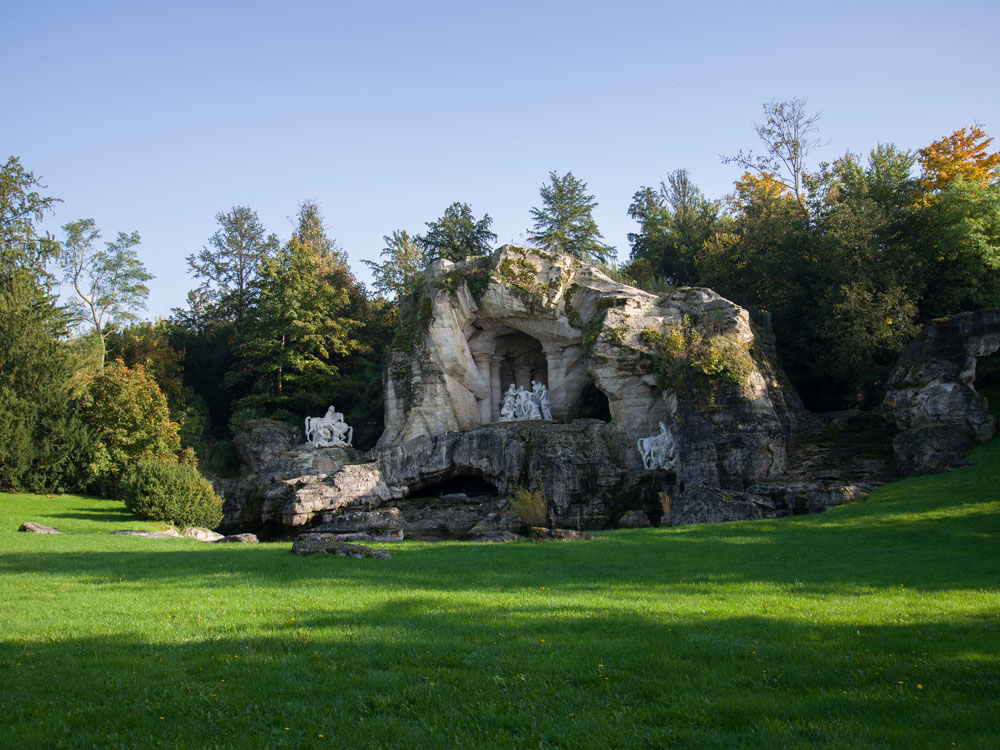
Today's Apollo's Baths Grove dates from the reign of Louis XVI and was laid out between 1778 and 1781. In the same location, Le Nôtre initially installed the picturesque Marsh Grove in 1670, its principal decoration consisting of a pool bordered by lifelike painted metal reeds and adorned in its centre by a metal tree with a fountain springing from it. In 1705 this fantastical grove was eliminated to make room for the groups Apollo Served by Nymphs and Horses of the Sun, which Jules Hardouin-Mansart placed under gilded lead canopies and on pedestals surrounded by a pool. The west part of the grove was laid out under Louis XV for the Dauphin. The two parts of the grove were completely modified under Louis XVI. The painter Hubert Robert designed an English-style garden with its centre occupied by a lake, overlooked by an immense artificial rock enhanced with cascades and a grotto where the Apollo group was installed, while the two Horses of the Sun groups were positioned on either side.
Star Grove

The Star Grove, laid out in 1666, took its name from its shape, one of the most complex in the garden. It was reached by four pathways leading from the corners of the surrounding woods. These pathways led to a circular walkway surrounding the grove, from which only two meandering paths led further inward. These paths led in turn to a new pathway in the form of a pentagon, from the corners of which final pathways led to the centre of the grove and its pool. In 1671 a stone embellishment was added in the form of a large rock. The grove then came to be known as the Water Mountain. Early in the 18th century the grove was modified profoundly and its complicated layout was eliminated along with the pool. A restoration programme has recently reproduced a part of the plan used by Le Nôtre (circular pathway and meandering paths), with the heart of the grove remaining a lawn.
Water Theatre Grove

The Water Theatre Grove was laid out between 1671 and 1674 and enabled the hydraulics engineers François and Pierre Francine to deploy their talents to the full. Designed as an open-air theatre, the grove consisted of a space destined for spectators and a stage devoted to every possible combination of fountain show, often forming figures considered to be sheer technical wizardry. Being extremely costly to maintain, the Water Theatre was replaced at the end of the 18th century by the more modest Green Ring Grove. The Palace of Versailles launched an international competition in 2009 to restore the grove. The project submitted by landscaper Louis Benech and artist Jean-Michel Othoniel was retained and the new grove was inaugurated in 2015.
To the west of the grove, a small pool was installed in 1709 representing an island with gilded metal children at play.
The Golden Children's Pool just off the Water Theatre Grove was installed by Jules Hardouin-Mansart in 1709. This small oval pool is adorned at its centre with a group of eight lead cherubs, sculpted in 1704 by Jean Hardy and originally intended for the pools in Marly Park, and finally transferred to Versailles in 1709. A veritable masterpiece among the lead statues in the Versailles gardens, it testifies to Louis XIV's fondness for childhood after the death of his descendants cast a pall over the end of his reign. The Golden Children's Pool was restored in 2016, sponsored by the Fondation BNP Paribas and the skills sponsorship of the company D’Huart Industrie.
Grove of the Three Fountains
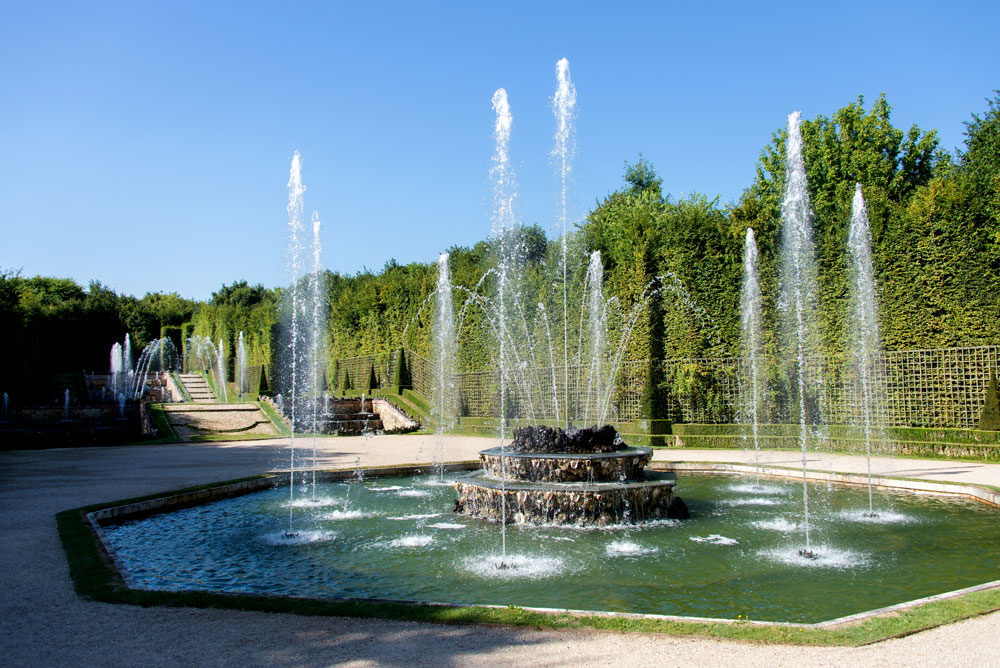
This grove was created by Le Nôtre in 1677 and is the only one mentioned on an old map as being "the King's idea". Running parallel to the Water Walk, the natural slope dictated the layout over three distinct levels linked by cascades. Restored in 2005, it recovered its design and the water effects desired by the sovereign: in the lower pool, the water jets form a fleur-de-lys, in the middle one a watery vault, and in the upper pool a water column formed by one hundred and forty water jets.
Triumphal Arch Grove

All that remains of the Triumphal Arch Grove installed by Le Nôtre between 1677 and 1684 is the lower part, near the Neptune Fountain. It was reached, and is still reached, from the upper terrace, by a great Triumphal Arch of golden metal gleaming with water jets and cascades. On either side water buffets and golden metal pyramids lent added splendour to the grove. Below it the Fountain of France Victorious by the sculptors Coysevox, Tuby and Prou, lent added meaning to the whole grove by celebrating the King's military victories.




